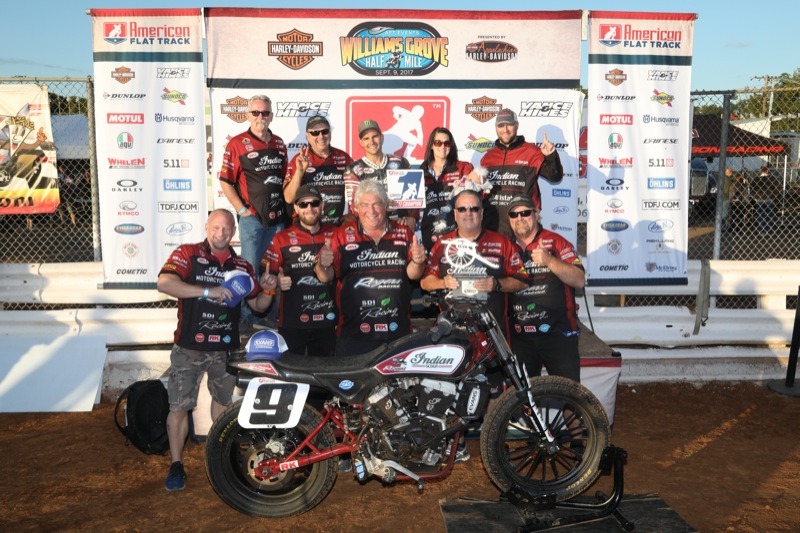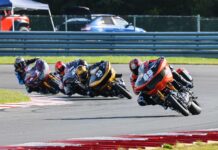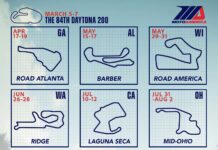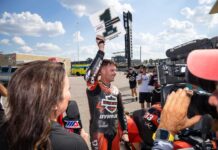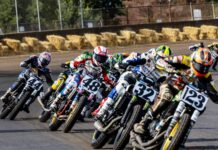Bigger, better and faster
When the green flag dropped at Daytona last year for the first flat track race of the season no one knew what to expect.
Under a new director with a new class structure, the series—which traces its history back to the early 1920s and is now officially renamed American Flat Track—brought a number of firsts with it to the World Center Of Racing:
• It was the first time a flat track race was held inside the Nascar oval. Tons of dirt were trucked in to build the track on the grassy area between the tri-oval and the Nascar pit lane. Fans could watch all the action from seats in Daytona’s new Motorsports Stadium
• Harley-Davidson introduced a new bike, the XG750R, to replace its tried-and true XR750—a model first raced in 1970 and campaigned to 29 national flat track championships since then. (That’s also the bike Evel Knievel attempted most of his famous jumps)
• Indian returned to professional racing for the first time since 1953 with an all-new race program and new purpose-built bike, the FTR750
• The revival of the epic Harley–Indian racing battle sparked interest in many first-time spectators as well as longtime fans
• A new web-streaming and TV package allowed viewers at home to watch the races for the first time since the early ’80s

–Photo courtesy of Indian Motorcycle
These changes are reviving the sport, which is a good thing; it needed a serious kick in the butt. The on-track action was always exciting. The racing was hard, close, fast, loud and good, but the patchwork rule and class structure had gotten so convoluted that a Harley team rider actually won the championship just a couple years ago by earning most of his points while mounted on a Honda. (I could explain, but we don’t have enough room in this piece.)
Michael Lock, the new CEO of the series, began the turn around by simplifying the class structure, which made the series attractive to Indian Motorcycle and prompted Harley-Davidson to develop their new bike, and that made the series interesting to television again. Home viewers watched and those fans got off the couch and went to live events bringing higher attendance at races… and on and on… and it’s snowballed as these things tend to do once someone gets the ball rolling.
So here’s where we stand today. Harley-Davidson’s XG750R and Indian’s FTR750 are the stars of the premier class, AFT Twins, with both factory teams fielding three riders each. Smaller teams and privateers race on Triumphs, Kawasakis or Yamahas along with the older Harley-Davidsons XR750s. Displacement can vary from 750cc up to 1000cc depending on certain variables with the bikes. The Indian FTR750 is available for purchase to private teams for around $50K. Harley-Davidson has not yet announced whether the XG750R will be available this season, but if not this year it will be eventually. The AFT Singles class consists of 450cc single-cylinder bikes from the Japanese big four and two other European manufactures. There are four track layouts: three ovals, the Mile, the Half-Mile and the Short Track, along with the TT configuration, which combines right- and left-hand turns with a jump.

–Photo courtesy of Harley-Davidson
Officially, at the time of this writing, there are 18 races scheduled for 2018 but others may be added as time and circumstance allow (someone is having a big birthday party this year, so that may open up a possibility). Four of the races will be TTs, eight are Miles; Half-Miles and Short Track make up the rest. On race day all teams get practice and qualifying sessions throughout the afternoon before the evening program, which will be a series of heat (elimination) races for the two classes before the main event: 15-lap races for AFT Singles and 25 laps for AFT Twins with 18 riders in each.
Along with making the racing itself more understandable and accessible for fans, American Flat Track is hosting activities, exhibits, bike shows, motorcycle-themed kids’ play zones, autograph sessions with the riders, music, food and support-class racing at various events around the country so fans and families can make a day of it. The heat races and main event are scheduled to run three hours. Discounted tickets are available to military, first responders and law enforcement personnel through the govx.com website.
So, what happened last season between Harley-Davidson and Indian?

Both teams came to the track with new models, and conventional wisdom in racing circles is that the first year with new machinery is basically a development year. Harley followed that convention but Indian had other ideas. Indian won 14 of the 18 races throughout the season with six of those being all-Indian podiums. They easily swept the championship with their riders finishing the season 1st, 2nd, and 3rd in points.
Harleys only made the podium twice—a 3rd place at the Buffalo Chip TT in Sturgis on a factory XG750R and one win by a privateer on a XR750 at a Half-Mile in Texas. But looking back through history this is almost to be expected with a new bike. The XR took two years of development after is introduction in 1970 before it became what many call the most successful race bike of all time. Scott Beck, Harley-Davidson director of marketing, expressed the Motor Company’s optimism this way: “We like where we are, we love what we learned and felt really good where we were power-wise and learned a lot in how to get that power to the track.” He said they’ve adjusted the chassis setup and suspension during the off season and made some personnel changes to the team and they are optimistic for the year. Harley is backing up that optimism with $562,500 in contingency money to XG and XR racers this year.

Indian’s Gary Gray, vice president of Racing, Technology and Service, summed up their thoughts on the season: “It was obviously a great year for us. We didn’t enter 100-percent confident; we expected maybe five podiums throughout the year, and we didn’t expect a 1, 2, 3 in the championship with only three bikes in the field. It was pretty amazing.” They will be supporting several privateers on the FTR750 and have put up $358,000 in contingency for those riders.
Combining Harley-Davidson’s and Indian’s contingency funds with contributions from other supporting businesses, racers have almost $2 million in purse money available this season. With that much incentive on the other side of the checkered flag, every rider will be giving it everything they have.
This should be an exciting year. We’re all looking to see what Harley-Davidson brings to Indian this season and we will get a to see that at the opener in Daytona on March 15. The TT track at Daytona has been reconfigured and widened from last year’s layout prompting American Flat Track’s new catchphrase for the season: Bigger, Better and Faster. I’m looking forward to it. (americanflattrack.com)
Check out the 2018 American Flat Track Race Schedule.


